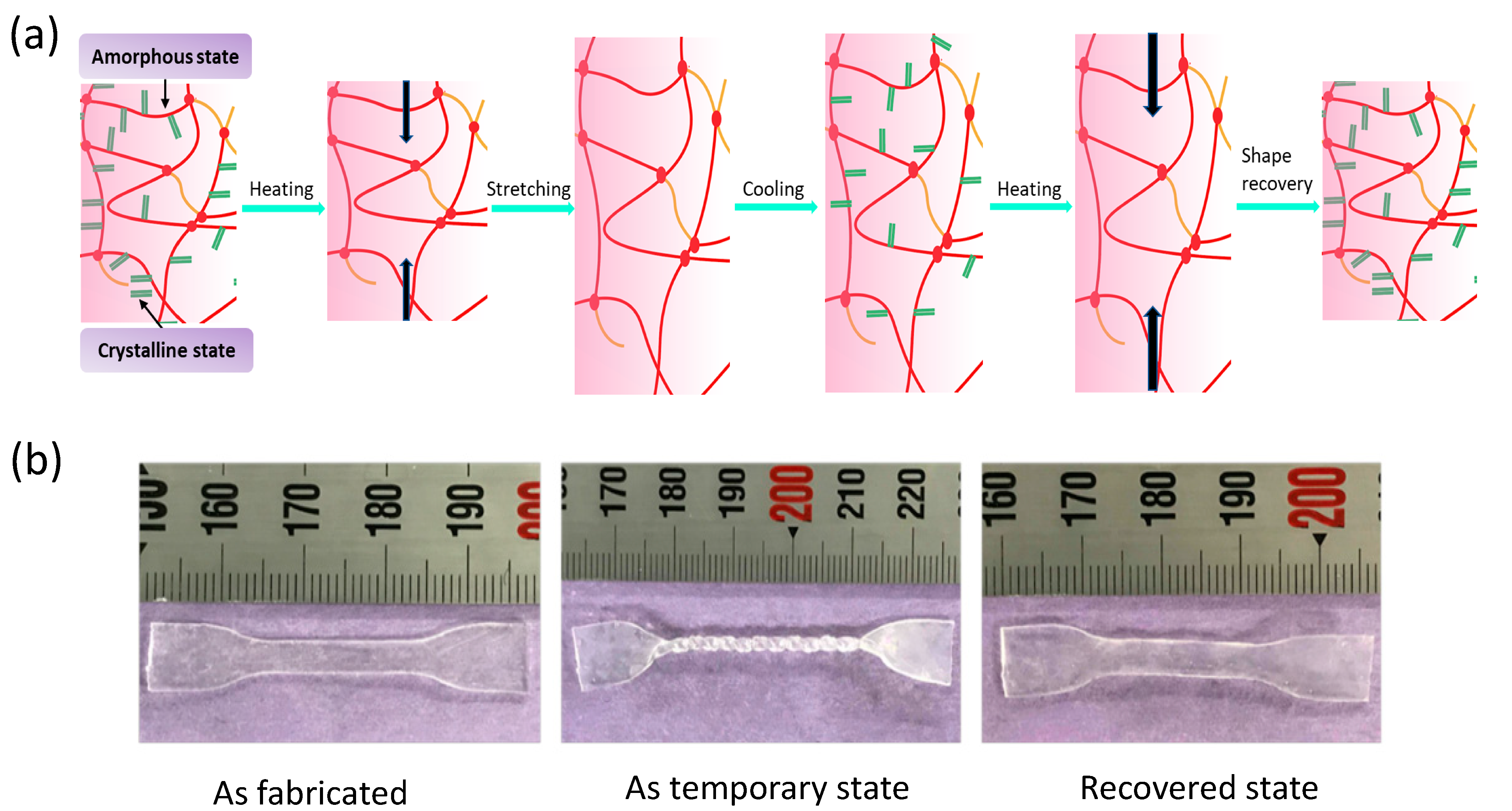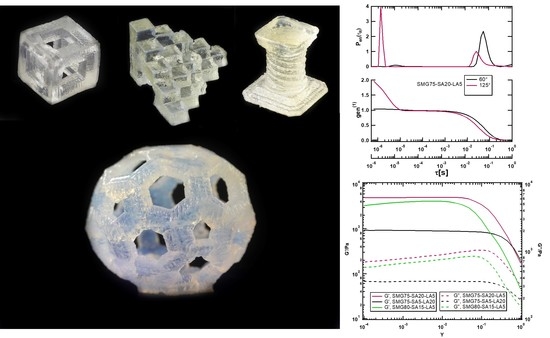Light Scattering and Rheological Studies of 3D/4D Printable Shape Memory Gels Based on Poly (N,N-Dimethylacrylamide-co-Stearyl Acrylate and/or Lauryl Acrylates)
Abstract
:1. Introduction
2. Materials and Methods
2.1. Materials
2.2. Preparation of SMG Samples
2.3. Method of Characterization
3. Results and Discussion
3.1. 3D/4D Printability of SMGs
3.2. Demonstration of Shape Memory Assisted Healing Properties
3.3. Mesh Size and Crosslinking Densities of SMGs Calculated by SMILS
3.4. Rheology Study and Estimation of Crosslinking Density and Mesh Size of SMGs
4. Conclusions
Supplementary Materials
Author Contributions
Funding
Informed Consent Statement
Data Availability Statement
Acknowledgments
Conflicts of Interest
References
- Chia, H.N.; Wu, B.N. Recent advances in 3D printing of biomaterials. J. Biol. Eng. 2015, 9, 4. [Google Scholar] [CrossRef] [PubMed] [Green Version]
- Zarek, M.; Layani, M.; Cooperstein, I.; Sachyani, E.; Cohn, D.; Magdassi, S. 3D Printing of Shape Memory Polymers for Flexible Electronic Devices. Adv. Mater. 2016, 28, 4449–4454. [Google Scholar] [CrossRef] [PubMed]
- Jeong, B.; Gutowska, A. Lessons from nature: Stimuli-responsive polymers and their biomedical applications. Trends. Biotechnol. 2002, 20, 305–311. [Google Scholar] [CrossRef]
- Matsumoto, A.; Yoshida, R.; Kataoka, K. Glucose-Responsive Polymer Gel Bearing Phenylborate Derivative as a Glucose-Sensing Moiety Operating at the Physiological pH. Biomacromolecules 2004, 5, 1038–1045. [Google Scholar] [CrossRef] [PubMed]
- Yamato, M.; Okano, T. Cell sheet engineering. Mater. Today 2004, 7, 42–47. [Google Scholar] [CrossRef]
- Osada, Y.; Matsuda, A. Shape memory in hydrogels. Nature 1995, 376, 219. [Google Scholar] [CrossRef]
- Shiblee, M.N.I.; Ahmed, K.; Khosla, A.; Kawakami, M.; Furukawa, H. 3D printing of shape memory hydrogels with tunable mechanical properties. Soft Matter 2018, 14, 7809–7817. [Google Scholar] [CrossRef]
- Shiblee, M.N.I.; Ahmed, K.; Kawakami, M.; Furukawa, H. 4D Printing of Shape-Memory Hydrogels for Soft-Robotic Functions. Adv. Mater. Technol. 2019, 4, 1900071. [Google Scholar] [CrossRef]
- Ahmed, K.; Shiblee, M.N.I.; Khosla, A.; Nagahara, L.; Thundat, T.; Furukawa, H. Review—Recent Progresses in 4D Printing of Gel Materials. J. Electrochem. Soc. 2020, 167, 037563. [Google Scholar] [CrossRef]
- Ahmed, K.; Naga, N.; Kawakami, M.; Furukawa, H. Extremely Soft, Conductive, and Transparent Ionic Gels by 3D Optical Printing. Macromol. Chem. Phys. 2018, 1800216. [Google Scholar] [CrossRef]
- Ahmed, K.; Kawakami, M.; Khosla, A.; Furukawa, H. Soft, conductive nanocomposites based on ionic liquids/carbon nanotubes for 3D printing of flexible electronic devices. Polym. J. 2019, 51, 511–521. [Google Scholar] [CrossRef]
- Rahman, M.S.; Shiblee MN, I.; Ahmed, K.; Khosla, A.; Ogawa, J.; Kawakami, M.; Furukawa, H. Flexible and Conductive 3D Printable Polyvinylidene Fluoride and Poly(N,N-dimethylacrylamide) Based Gel Polymer Electrolytes. Macromol. Mater. Eng. 2020, 305, 2000262. [Google Scholar] [CrossRef]
- De Gennes Scaling, P.G. Concepts in Polymer Physics; Cornell University Press: Ithaca, NY, USA, 1979. [Google Scholar]
- Oikawa, H.; Murakami, K. Dynamic light scattering of swollen rubber vulcanizates and the swelling mechanism. Macromolecules 1991, 24, 1117–1122. [Google Scholar] [CrossRef]
- Sakai, T.; Kurakazu, M.; Akagi, Y.; Shibayama, M.; Chung, U.-I. Effect of swelling and deswelling on the elasticity of polymer networks in the dilute to semi-dilute region. Soft Matter 2012, 8, 2730–2736. [Google Scholar] [CrossRef]
- Karvinen, J.; Ihalainen, T.O.; Calejo, M.T.; Jönkkäri, I.; Kellomäki, M. Characterization of the microstructure of hydrazone crosslinked polysaccharide based hydrogels through rheological and diffusion studies. Mater. Sci. Eng. C 2019, 94, 1056–1066. [Google Scholar] [CrossRef] [PubMed]
- Rüchel, R.; Brager, M.D. Scanning electron microscopic observations of polyacrylamide gels. Anal. Biochem. 1975, 68, 415–428. [Google Scholar] [CrossRef]
- Marmorat, C.; Arinstein, A.; Koifman, N.; Talmon, Y.; Zussman, E.; Rafailovich, M. Cryo-Imaging of Hydrogels Supermolecular Structure. Sci. Rep. 2016, 6, 25495. [Google Scholar] [CrossRef] [Green Version]
- Norisuye, T.; Takeda, M.; Shibayama, M. Cluster-Size Distribution of Cross-Linked Polymer Chains across the Gelation Threshold. Macromolecules 1998, 31, 5316–5322. [Google Scholar] [CrossRef]
- Fang, L.; Brown, W.; Konak, C. Dynamic Light Scattering Study of the Sol-Gel Transition. Macromolecules 1991, 24, 6839. [Google Scholar] [CrossRef]
- Lesturgeon, V.; Nicolai, T.; Durand, D. Dynamic and static light scattering study of the formation of cross-linked PMMA gels. Eur. Phys. J. B 1999, 9, 71–82. [Google Scholar] [CrossRef]
- Adam, M.; Lairez, D.; Karpasas, M.; Gottlib, M. Static and Dynamic Properties of Cross-Linked Poly(dimethylsiloxane) Pregel Clusters. Macromolecules 1997, 30, 5920–5929. [Google Scholar] [CrossRef]
- Trappe, V.; Bauer, J.; Weissmuller, M.; Burchard, W. Angular Dependence in Static and Dynamic Light Scattering from Randomly Branched Systems. Macromolecules 1997, 30, 2365–2372. [Google Scholar] [CrossRef]
- Furukawa, H.; Horie, K. Swelling-induced modulation of static and dynamic fluctuations in polyacrylamide gels observed by scanning microscopic light scattering. Phys. Rev. E 2003, 68, 031406. [Google Scholar] [CrossRef] [PubMed]
- Furukawa, H.; Hidema, R.; Takada, H.; Amano, Y.; Kabir, M.H.; Gong, J. Smart hydrogels developed with inter-crosslinking network (ICN) structure. J. Solid. Mech. Mater. Eng. 2013, 7, 245–250. [Google Scholar] [CrossRef] [Green Version]
- Takada, G.; Hidema, R.; Furukawa, H. Ultrahigh ductile gels developed by inter cross-linking network (ICN). J. Solid. Mech. Mater. Eng. 2012, 6, 169–177. [Google Scholar] [CrossRef] [Green Version]
- Ahmed, K.; Watanabe, Y.T.; Higashihara, T.; Arafune, H.; Kamijo, T.; Morinaga, T.; Sato, T.; Makino, M.; Kawakami, M.; Furukawa, H. Investigation of mechanical properties and internal structure of novel ionic double-nework gels and comparison with conventional hydrogels. Microsyst. Technol. 2016, 22, 17–24. [Google Scholar] [CrossRef]
- Welzel, P.B.; Prokoph, S.; Zieris, A.; Grimmer, M.; Zschoche, S.; Freudenberg, U.; Werner, C. Modulating biofunctional starPEG heparin hydrogels by varying size and ratio of the constituents. Polymers 2011, 3, 602–620. [Google Scholar] [CrossRef] [Green Version]
- Rubinstein, R.H.M. Colby, Polymer Physics; Oxford University Press: New York, NY, USA, 2003. [Google Scholar]





| Gel Systems | Diffusion Coefficient, D | Mesh Size, ξs (nm) | Crosslinking Density, νs (m−3) |
|---|---|---|---|
| SMG75-SA20-LA5 | 4.92 × 10−10 | 1.13 | 6.93 × 1026 |
| SMG75-SA5-LA20 | 3.97 × 10−10 | 1.40 | 3.64 × 1026 |
| SMG80-SA15-LA5 | 4.11 × 10−10 | 1.35 | 4.06 × 1026 |
| Gel Systems | Storage Modulus, G’ (Pa) | Crosslinking Density, νR (m−3) | Mesh Size ξR |
|---|---|---|---|
| SMG75-SA20-LA5 | 4922 | 1.17 × 1024 | 9.5 |
| SMG75-SA5-LA20 | 926 | 2.21 × 1023 | 16.5 |
| SMG80-SA15-LA5 | 3759 | 8.98 × 1023 | 10.3 |
Publisher’s Note: MDPI stays neutral with regard to jurisdictional claims in published maps and institutional affiliations. |
© 2020 by the authors. Licensee MDPI, Basel, Switzerland. This article is an open access article distributed under the terms and conditions of the Creative Commons Attribution (CC BY) license (http://creativecommons.org/licenses/by/4.0/).
Share and Cite
Shiblee, M.N.I.; Ahmed, K.; Yamazaki, Y.; Kawakami, M.; Furukawa, H. Light Scattering and Rheological Studies of 3D/4D Printable Shape Memory Gels Based on Poly (N,N-Dimethylacrylamide-co-Stearyl Acrylate and/or Lauryl Acrylates). Polymers 2021, 13, 128. https://doi.org/10.3390/polym13010128
Shiblee MNI, Ahmed K, Yamazaki Y, Kawakami M, Furukawa H. Light Scattering and Rheological Studies of 3D/4D Printable Shape Memory Gels Based on Poly (N,N-Dimethylacrylamide-co-Stearyl Acrylate and/or Lauryl Acrylates). Polymers. 2021; 13(1):128. https://doi.org/10.3390/polym13010128
Chicago/Turabian StyleShiblee, MD Nahin Islam, Kumkum Ahmed, Yuta Yamazaki, Masaru Kawakami, and Hidemitsu Furukawa. 2021. "Light Scattering and Rheological Studies of 3D/4D Printable Shape Memory Gels Based on Poly (N,N-Dimethylacrylamide-co-Stearyl Acrylate and/or Lauryl Acrylates)" Polymers 13, no. 1: 128. https://doi.org/10.3390/polym13010128







